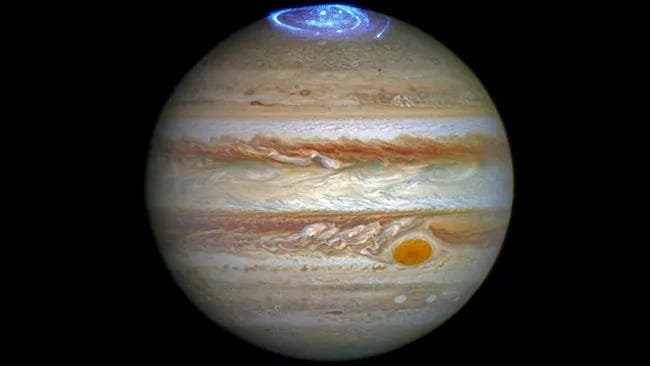Space.com Q&A on Jupiter
Discussing Jupiter for a reference article for space.com.
In March, I was invited to answer a series of questions for Space.com about Jupiter - you can see the full article here, but here are the responses I came up with for their reporter:

1. Is Jupiter a gas planet?
Yes, but don’t be fooled into thinking that Jupiter is like a big cloud of gas that you could fly through, it’s more like a fluid planet that gets denser and hotter the deeper you go. Pressures at the colourful cloud tops are not dissimilar to those in Earth’s atmosphere, but they build up as you go deeper, rather like a submarine experiencing crushing densities as it sinks deeper and deeper into our oceans. In fact, the hydrogen that is Jupiter’s dominant gas gets compressed to such extremes that it changes to an exotic metallic hydrogen form. So think of Jupiter as a bottomless ocean of strange, exotic materials.
2. What is the Great Red Spot on Jupiter?
Jupiter’s famous Great Red Spot is a swirling vortex – technically an anticyclone because it rotates anticlockwise in Jupiter’s southern hemisphere. This vortex is big enough to swallow the Earth twice over, and the winds that whip around its edges do a good job of keeping the calm air inside the vortex separated from turbulent, stormy air outside. The calm air in the interior gets cooked by the ultraviolet light from the Sun, creating chemicals and hazes that are very good absorbers of blue light, leaving only red light to be reflected back towards an observer. The Great Red Spot has been around since at least the Victorian era, almost two centuries ago, but has been steadily shrinking in east-west extend for much of that time.

3. Is there a planet bigger than Jupiter?
Almost certainly, but not here in our Solar System. Jupiter and Saturn are the big Gas Giants, Uranus and Neptune are more “intermediate-sized” Ice Giants, whereas the rocky terrestrial planets are much smaller. When we look out at the incredible range of exoplanets being discovered around other stars, more than 5000 at the last count, we do see evidence for larger planets, some of which are “puffed up” because they’re really close to their parent stars and getting a lot of energy from them to heat their atmospheres to thousands of degrees.
4. Why is Jupiter sometimes called a "failed star"?
Jupiter and the other giant planets are essentially made of the same stuff as the Sun, albeit with a few changes to the basic ingredients beyond hydrogen and helium. So give them a lot more material to start with, and they could ignite nuclear fusion of their hydrogen to form helium, therefore becoming a star. But brown dwarfs sit in between giant planets and main-sequence stars, too small and light to burn hydrogen, but possibly heavy enough to burn deuterium via nuclear fusion, when they’re about 13 times more massive than our Jupiter.

